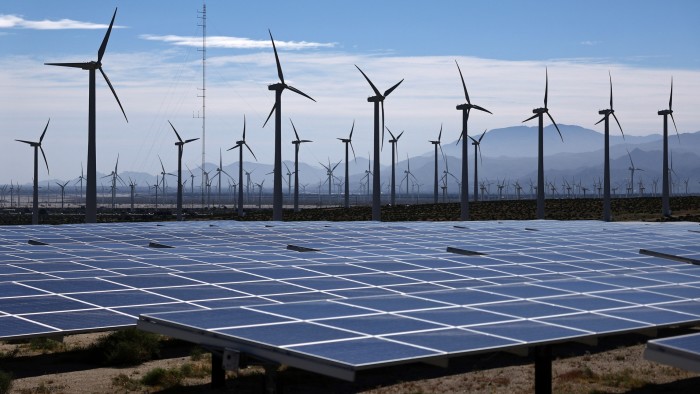Donald Trump’s US election victory has dealt a blow to the renewable energy industry, prompting at least half a dozen developers to put projects on hold and investors to dump shares.
Canadian solar manufacturer Heliene is pausing progress on its $150mn plan to manufacture solar cells in the US until it gets more policy clarity from the incoming Trump administration. Battery recycling start-up Princeton NuEnergy is reconsidering its timeline to build a $300mn factory in 2028, the companies told the Financial Times.
Clean energy fears Trump’s re-election spells doom for the industry. The president-elect has vowed to turbo-charge the country’s oil and gas production and do away with President Joe Biden’s climate policies on the campaign trail, including repealing the Inflation Reduction Act, the strongest action the US has taken to boost renewable energy.
“We’re holding our breath before further investments can go ahead,” said Martin Pochtaruk, chief executive of Heliene. Solar Energy Manufacturers For America, a coalition that includes the largest US solar manufacturers, estimates about a “half a dozen” projects are waiting for more clarity from the new administration.
“They need more certainty before they can make those hundred million dollar, billion dollar bets,” said Mike Carr, the association’s president.
Trump’s election and the likelihood of a Republican-controlled Congress have sent renewables stocks tumbling, as investors fear a slowdown in the country’s pace of decarbonisation under a Republican trifecta government.
The iShares Global Clean Energy ETF, which tracks renewables companies, fell 7 per cent after Trump’s defeat of vice-president Kamala Harris, while shares for First Solar and Denmark’s Vestas slipped about 10 per cent. Fuel cell maker Plug Power and residential solar service provider Sunnova were down by more than a quarter.
Funds that were positioned short against renewable names scored more than $1 billion in profits off the trade.
“Everyone’s now just kind of in a wait-and-see mode, as well as a contingency planning mode,” said Alan Alexander, a partner at Vinson & Elkins, a law firm that works on energy projects.
Enacted in 2022, the IRA transformed the US into a top market for clean energy investment and turbocharged the country’s pace of decarbonisation, spurring nearly $450bn in private investment since its passage, according to the Clean Investment Monitor.
Trump has repeatedly attacked the IRA on the campaign trail, calling it a “green new scam” and vowing to “terminate” the $370bn in federal support for clean energy under the law. He’s also vowed to unleash the country’s oil and gas production and stop offshore wind projects and electric vehicle mandates on “day one” if elected.
Wood Mackenzie estimates renewable deployment could fall 30 per cent if the tax credits are phased out and there are new tariffs on equipment and restrictions on permitting.
“It is a big challenge to net zero,” said David Brown, director of the energy transition practice at Wood Mackenzie. “It’s likely that this election could put us on a delayed transition trajectory.”
Multiple executives and analysts told the FT that the economic case for renewable projects will continue under Trump and expect IRA tax credits for power generation and manufacturing to remain intact. Despite interest rate pressures, solar and onshore wind remain the cheapest sources of new electricity, according to Lazard.
“We feel good about the future and how it’s going to go under a Trump administration,” said Eric Dresselhuys, chief executive of ESS, a battery storage manufacturer in Oregon.
While Trump rolled back restrictions on fossil fuel production and emissions standards, he also renewed tax credits for solar and wind projects and electric vehicles. Solar and wind installations grew 32 per cent and 69 per cent during Trump’s first term as president while electric vehicle sales more than doubled, according to a Raymond James analysis.
Analysts expect offshore wind and electric vehicles to be hardest hit under Trump. Unlike solar and onshore wind, offshore wind projects require federal permits, and electric vehicles have become a culture war issue since Trump’s first term.
Chao Yan, chief executive of Princeton NuEnergy, warned that Trump’s proposed tariffs could increase the cost of components and equipment for renewable production and hurt domestic manufacturers.
The incoming president has pledged a 10-20 per cent tariff on all imports and a 60 per cent tariff on products from China, the dominant producer of clean technologies.
“It’s too much unknown. It’s hard to move,” Yan said. “We need to have time to internally discuss and also discuss with investors whether we need to keep the current speed or if we should be slowing down.”
The Biden administration has set a target to reduce emissions by 50 per cent to 52 per cent from 2005 levels. Wood Mackenzie estimates a second Trump term could result in 500mn tonnes of additional carbon emissions in the energy sector by 2030.
“The clean energy boom is not going to stop . . . it’s a question of will President Trump allow America to keep being a leader in this space, or will he cede America’s leadership role to other countries, especially adversaries like China,” said Andrew Reagan, executive director of Clean Energy for America, which in October co-launched a six-figure ad campaign in support of Harris.
Read the full article here

